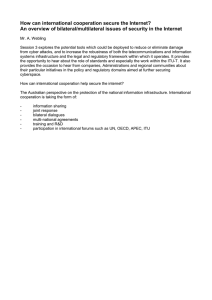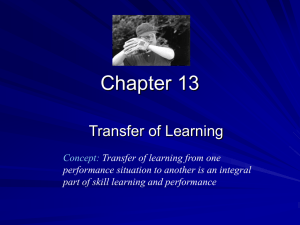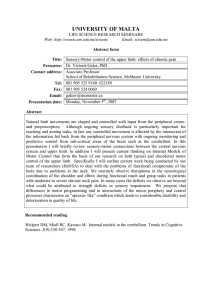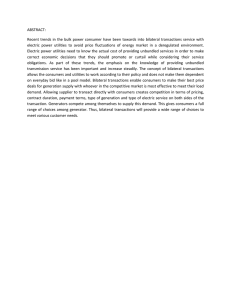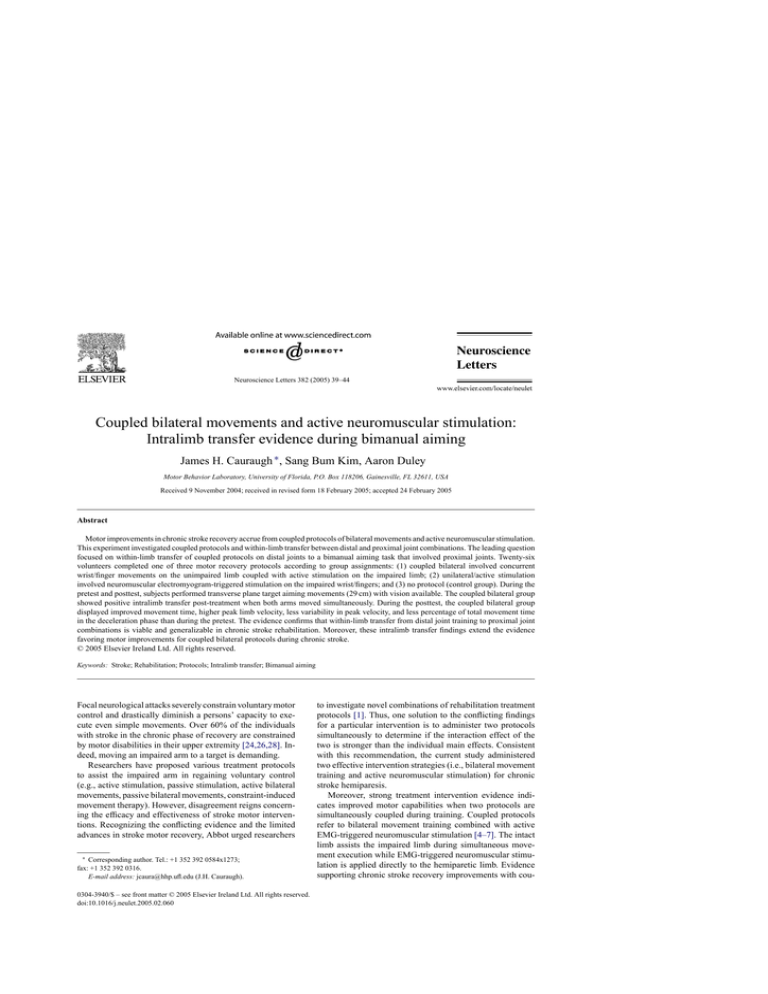
Neuroscience Letters 382 (2005) 39–44
Coupled bilateral movements and active neuromuscular stimulation:
Intralimb transfer evidence during bimanual aiming
James H. Cauraugh ∗ , Sang Bum Kim, Aaron Duley
Motor Behavior Laboratory, University of Florida, P.O. Box 118206, Gainesville, FL 32611, USA
Received 9 November 2004; received in revised form 18 February 2005; accepted 24 February 2005
Abstract
Motor improvements in chronic stroke recovery accrue from coupled protocols of bilateral movements and active neuromuscular stimulation.
This experiment investigated coupled protocols and within-limb transfer between distal and proximal joint combinations. The leading question
focused on within-limb transfer of coupled protocols on distal joints to a bimanual aiming task that involved proximal joints. Twenty-six
volunteers completed one of three motor recovery protocols according to group assignments: (1) coupled bilateral involved concurrent
wrist/finger movements on the unimpaired limb coupled with active stimulation on the impaired limb; (2) unilateral/active stimulation
involved neuromuscular electromyogram-triggered stimulation on the impaired wrist/fingers; and (3) no protocol (control group). During the
pretest and posttest, subjects performed transverse plane target aiming movements (29 cm) with vision available. The coupled bilateral group
showed positive intralimb transfer post-treatment when both arms moved simultaneously. During the posttest, the coupled bilateral group
displayed improved movement time, higher peak limb velocity, less variability in peak velocity, and less percentage of total movement time
in the deceleration phase than during the pretest. The evidence confirms that within-limb transfer from distal joint training to proximal joint
combinations is viable and generalizable in chronic stroke rehabilitation. Moreover, these intralimb transfer findings extend the evidence
favoring motor improvements for coupled bilateral protocols during chronic stroke.
© 2005 Elsevier Ireland Ltd. All rights reserved.
Keywords: Stroke; Rehabilitation; Protocols; Intralimb transfer; Bimanual aiming
Focal neurological attacks severely constrain voluntary motor
control and drastically diminish a persons’ capacity to execute even simple movements. Over 60% of the individuals
with stroke in the chronic phase of recovery are constrained
by motor disabilities in their upper extremity [24,26,28]. Indeed, moving an impaired arm to a target is demanding.
Researchers have proposed various treatment protocols
to assist the impaired arm in regaining voluntary control
(e.g., active stimulation, passive stimulation, active bilateral
movements, passive bilateral movements, constraint-induced
movement therapy). However, disagreement reigns concerning the efficacy and effectiveness of stroke motor interventions. Recognizing the conflicting evidence and the limited
advances in stroke motor recovery, Abbot urged researchers
∗ Corresponding author. Tel.: +1 352 392 0584x1273;
fax: +1 352 392 0316.
E-mail address: jcaura@hhp.ufl.edu (J.H. Cauraugh).
0304-3940/$ – see front matter © 2005 Elsevier Ireland Ltd. All rights reserved.
doi:10.1016/j.neulet.2005.02.060
to investigate novel combinations of rehabilitation treatment
protocols [1]. Thus, one solution to the conflicting findings
for a particular intervention is to administer two protocols
simultaneously to determine if the interaction effect of the
two is stronger than the individual main effects. Consistent
with this recommendation, the current study administered
two effective intervention strategies (i.e., bilateral movement
training and active neuromuscular stimulation) for chronic
stroke hemiparesis.
Moreover, strong treatment intervention evidence indicates improved motor capabilities when two protocols are
simultaneously coupled during training. Coupled protocols
refer to bilateral movement training combined with active
EMG-triggered neuromuscular stimulation [4–7]. The intact
limb assists the impaired limb during simultaneous movement execution while EMG-triggered neuromuscular stimulation is applied directly to the hemiparetic limb. Evidence
supporting chronic stroke recovery improvements with cou-
40
J.H. Cauraugh et al. / Neuroscience Letters 382 (2005) 39–44
pled bilateral movements and active stimulation include a
higher number of blocks moved, decreased reaction time,
and stable sustained muscle contractions [4–7].
An additional critical rehabilitation issue that has not been
addressed concerns transferring the improved motor capabilities within-limb. Are chronic stroke patients able to transfer the motor benefits of coupled bilateral training from the
distal wrist/finger joints to the proximal shoulder and elbow joints? Is within-limb distal joint training generalizable
to proximal joint combinations or is effector training specific to the involved joints [27]? To investigate within-limb
transfer of rehabilitation training on distal joints to proximal joint combinations, the present study implemented training on efficacious motor recovery protocols for the distal
wrist/finger extension while evaluating pretest/posttest performances on a non-practiced target-aiming task. Executing
the aiming task required proximal shoulder and elbow joint
combinations.
The distal treatment interventions involved wrist and finger extension movements according to group assignments.
The three groups were: (1) coupled bilateral (bilateral movements on the intact limb in combination with active stimulation on the impaired arm); (2) unilateral/active stimulation (only active stimulation on the impaired limb); and (3) a
healthy control group. Consistent with earlier coupled bilateral movement and active stimulation findings, we hypothesized that the coupled bilateral group would perform better on
the movement trajectory analyses (e.g., movement time, peak
velocity, time to peak velocity) of the target-aiming task than
the unilateral/active stimulation group. Specifically, we expected the coupled bilateral group distal training to transfer to
the proximal joints (shoulder and elbow) target-aiming task
with both arms performing better than the unilateral/active
stimulation group across the tests sessions.
Twenty-six participants volunteered and 21 of the subjects
were in the chronic stroke phase of recovery. Demographic
characteristics for participants are found in Table 1. Admission criteria for the rehabilitation protocol groups included:
(1) diagnosis of no more than three strokes; (2) a lower limit
of 10◦ of voluntary wrist/finger extension from a 80◦ wrist
flexed position; (3) no more than 80% upper limit of motor
recovery; (4) absence of other neurological deficits; and (5)
currently not participating in another upper extremity recovery program. This experiment received ethical approval from
the University of Florida’s Institutional Review Board prior
to being conducted.
Subjects performed sets of seven aiming movements in
three randomly ordered experimental conditions that varied
on hand combinations: left or right single-hand and twohanded movements [17]. Participants sat at a desk in front
of four medium-size switches (diameter: 6.35 cm) located
25.4 cm from the near edge of the desk. The home and
target switches were placed so that medial flexion adduction movements (29 cm) by each arm could be readily performed. Subjects started on the distal target switches (44 cm
to each side of the body’s midline) and moved medially to
target switches located 15 cm left and right of the midline
of the body. Subjects were instructed to depress the center
of each switch (activation level: 0.93 N) with their index and
middle fingers, and to execute the transverse plane movement between switches as quickly and accurately as possible. The medial movements involved flexion/adduction in the
transverse plane of the shoulder–elbow–wrist–finger linkage
[17]. Initiation of a trial began with the command “Ready”
and following a variable foreperiod interval (500, 1000, or
1500 ms), a 1 kHz 75 dB (A) SPL tone signaled movement
initiation. According to Fitts’ index of difficulty equation,
ID = log2 (2 × amplitude/target width), the distance and precision of the current medial movements equaled 3.17 [13].
All subjects performed 21 aiming trials during the pretest
and posttest sessions.
An electromagnetic data acquisition system recorded the
movement kinematics of each hand (Skill Technologies,
Phoenix). The magnetic field was sensitive to perturbations
of the sensors attached to the back of each hand (proximal
to the second finger’s knuckle). The sensors (X, Y, and Z coordinates) were sampled at a rate of 120 Hz, digitized, and
saved for subsequent off-line analyses.
The beginning and end of movements were defined by velocity profiles. Based on the central difference method, the
criterion for initiating movement was when the velocity profile exceeded 5 cm/s based on sample duration of 200 ms (i.e.,
24 samples). For the end of movement, the velocity profile
went from positive to zero; less than 5 cm/s for 24 data points.
Group assignment followed a randomization schedule in
that allocation to either the unilateral/active stimulation group
(n = 10) or the coupled bilateral group (n = 11) was completed
once subjects qualified on the pretest [2]. The control group
(n = 5) did not have any stroke history and they were recruited
for similar age and group gender composition.
For the active neuromuscular stimulation assistance (i.e.,
unilateral/active stimulation group and coupled bilateral
Table 1
Demographic characteristics of participants with mean years (standard deviation)
Group
Gender
Age (years)
Post-stroke time (years)
Stroke location
Unilateral/active stimulation
4 females; 6 males
63.29 (10.81)
3.57 (2.42)
4 left hemisphere
6 right hemisphere
Coupled bilateral
6 females; 5 males
69.37 (10.14)
4.73 (3.52)
2 left hemisphere
9 right hemisphere
Control
3 females; 2 males
54.48 (14.29)
No stroke history
No stroke history
J.H. Cauraugh et al. / Neuroscience Letters 382 (2005) 39–44
group), surface electrodes were attached to the extensor communis digitorum and extensor carpi ulnaris of the impaired
arm. For each wrist/finger extension movement, subjects voluntarily generated a criterion threshold level of EMG activity. On achieving the threshold, a Neuromove microprocessor
immediately provided an electrical stimulation that assisted
the wrist/finger extension muscles. Settings for the electrical
stimulation included: an initial threshold level of 50 V, 1 s
ramp up, 5 s of biphasic stimulation at 50 Hz, 15 to 29 mA
range, pulse width of 200 s, and 1 s ramp down. When the
EMG activity reached the target threshold, the device automatically increased the threshold for the next trial. If participants could not generate enough muscle activity to reach the
criterion, then the device lowered the activation level slightly.
Twenty-five seconds of rest separated consecutive trials. The
two stroke motor recovery groups completed 4 days of 90min training/week over 2 weeks.
The only assistance given to the voluntary wrist/finger extension in the unilateral/active stimulation group was EMGtriggered neuromuscular stimulation. In contrast, the coupled
bilateral group executed bilateral movements in the intact
wrist/fingers simultaneously with active stimulation on the
impaired limb. The control group followed the same testing procedures as the unilateral/active stimulation and coupled bilateral groups. However, the control group did not
complete any wrist/finger training sessions. Additionally, no
group practiced the aiming task between the pretest and
posttest.
Off-line calculations included median reaction time,
movement time, peak velocity, time-to-peak velocity, as well
as acceleration and deceleration phases. Shapiro-Wilk’s normality test indicated skewness violations in peak velocity and
time-to-peak velocity necessitating data transformations. A
square root transformation stabilized the data and achieved
normality [31]. The other dependent variables met the assumption of normality.
Separate mixed design three-way ANOVAs, Group
(unilateral/active stimulation, coupled bilateral, and control) × Test Session (pretest and posttest) × Impaired Limb
(alone or with the intact limb) analyzed the data. Group was
a between-subjects factor and the other two factors were
within-subjects: 3 × 2 × 2. The critical alpha level was set
at 0.05 for all statistical tests, and Tukey-Kramer’s multiple
comparison procedure served as a follow-up test.
The reaction time analysis revealed a significant
Group × Impaired Limb interaction [F2,23 = 8.32, P < 0.001].
The intact limb displayed faster reaction times for both the
unilateral/active stimulation (Med = 314 ms, S.D. = 59) and
coupled bilateral (Med = 296 ms, S.D. = 50) protocols groups
than the impaired limb (unilateral: Med = 390, S.D. = 84; coupled bilateral: Med = 375 ms, S.D. = 58). Stroke individuals
were slower at initiating aiming movements with their impaired limb than their intact limb. The analysis failed to identify a reliable reaction time test session (training) effect.
Four primary findings provide clear evidence favoring the
coupled bilateral movement and active stimulation treatment
41
effect in aiming movements. First, the movement time analysis indicated a reliable Group × Test Session interaction,
[F2,23 = 5.98, P < 0.01]. As shown in Table 2, the coupled bilateral group improved movement time pretest to posttest by
88 ms when collapsed across the testing situation conditions.
On the contrary, neither the unilateral group nor control group
revealed any significant decreased movement times.
Additional analysis of the single limb alone testing
condition identified a Group × Impaired Limb interaction,
[F2,23 = 5.65, P < 0.02]. The intact limb executed the 29 cm
movement faster than the impaired limb for both rehabilitation groups (unilateral: intact = 398 ms, S.D. = 102,
impaired = 672 ms, S.D. = 200; bilateral: intact = 355 ms,
S.D. = 47, impaired = 641 ms, S.D. = 191). In comparison, the
control group performed left and right hand movements
with equivalent movement times (242 and 264 ms). Further,
this two-way interaction failed significance when both limbs
moved together.
Second, peak limb velocity revealed a significant
Group × Test Session × Impaired Limb interaction,
[F2,23 = 3.83, P < 0.038] (see Table 2). The coupled bilateral
group from pretest to posttest improved their peak velocity
when both the impaired and intact limbs moved together.
On the contrary, peak velocity remained the same when the
impaired limb moved alone. The unilateral/active stimulation group performed with higher peak velocity during the
posttest in the impaired limb moved alone condition. Further,
the control group increased peak velocities across the test
sessions when moving their non-dominant limb alone.
Third, the variability in the peak velocity findings further
differentiated the treatment group by test session by impaired
limb interaction, [F2,23 = 4.16, P < 0.029]. As seen in Table 2,
the coupled bilateral group displayed no change in the variability (standard deviation) results across the test sessions or
impaired limb conditions. There were consistent peak velocity movements to the targets with one arm or both arms. On the
other hand, the unilateral/active stimulation group increased
peak velocity variability in the single limb testing condition.
Further, the control group increased variability significantly
in the one hand testing condition and decreased variability in
the two hand testing condition.
Fourth, analysis of the deceleration time (i.e., movement
phase 2 from peak velocity to target switch touch) differentiated the coupled bilateral movement and active stimulation
group across the test sessions when concurrently moving the
intact arm with the impaired limb, [F2,23 = 4.35, P < 0.026].
For both arms moving together, the coupled bilateral group
shortened deceleration time considerably from the pretest to
posttest. Moving the impaired limb alone did not improve
deceleration times. The changes in deceleration times were
contrary for the unilateral/active stimulation group. Specifically, the unilateral/active stimulation group demonstrated
longer deceleration times when both arms approached the
targets in the posttest than in the pretest. The control group
showed equivalent deceleration times across limb combinations and test sessions.
±
±
±
±
±
293
268
13.79
4.39
137
78
189
1.56
0.71
244
±
±
±
±
±
386
619
9.10
3.47
501
75
263
1.77
0.92
222
±
±
±
±
±
376
767
8.72
3.59
519
50
33
0.46
1.5
21
±
±
±
±
±
294
271
14.14
4.81
135
70
234
1.56
0.91
239
±
±
±
±
±
382
751
8.83
3.31
598
79
285
1.84
0.88
256
±
±
±
±
±
Note. RT: reaction time; MT: movement time; Uni: unilateral/active stimulation; Bil: coupled bilateral; Con: control.
413
798
8.47
3.23
550
23
33
1.12
1.1
24
±
±
±
±
±
281
259
14.17
5.18
135
64
185
1.43
1.3
186
±
±
±
±
±
384
619
9.32
3.51
428
77
191
1.33
1.4
174
±
±
±
±
±
381
662
9.13
3.51
452
57
45
0.55
1.2
27
±
±
±
±
±
276
268
13.68
4.19
143
55
199
1.37
0.93
211
±
±
±
±
±
Uni group
Con group
Bil group
Con group
Bil group
366
663
9.31
3.80
438
RT (ms)
399 ± 91
MT (ms)
681 ± 214
Peak velocity (cm/s)
8.81 ± 1.32
S.D. peak velocity
3.05 ± 0.82
Deceleration time (ms) 457 ± 199
Bil group
Uni group
Uni group
Uni group
Bil group
Pretest
Posttest
Pretest
Con group
Posttest
Impaired limb with intact limb
Impaired limb alone
Dependent measure
Table 2
Median performances (±S.D.) for the three groups as a function of test session (pre and post) and testing condition (impaired limb alone and impaired limb with intact limb)
34
25
0.71
1.0
20
J.H. Cauraugh et al. / Neuroscience Letters 382 (2005) 39–44
Con group
42
This study determined that within-limb transfer from distal joints to a combination of proximal joints was feasible.
Coupled protocols (i.e., simultaneous onset of bilateral movements in the wrist/fingers of both hands along with onset of
active stimulation on the impaired limb) training improved bimanual aiming that required shoulder and elbow joints movements. Peak velocity, variability in peak velocity, and deceleration time (adjustment phase) findings revealed a target
aiming task advantage for the coupled bilateral group, especially when both arms moved together.
The positive transfer identified from the practiced (trained)
distal coupled bilateral protocols (wrist/finger: extension)
to the proximal joint combinations of the upper extremity
(shoulder/elbow joints: flexion and adduction). These results
are consistent with recent findings by Vangheluwe et al. [27].
They reported positive transfer in star/line drawing withinlimb distal to proximal, and the active neurophysiological
mechanisms involved in within-limb transfer appear to be
the intrahemispheric supplementary motor areas [18,19,21].
In addition, the current within-limb transfer findings contribute to the bimanual aiming literature. Previous target aiming studies on individuals with chronic stroke investigated the
limitations and adaptations used in executing movements.
Levin and colleagues reported that upper extremity movements to targets in the frontal plane typically involved the
upper trunk [8,20]. Further, a set of experiments by Winstein et al. indicated that for reciprocal aiming movements,
limb transport and targeting activated population encoded
cortical–subcortical loops [32,33]. Nevertheless, the present
study was the first stroke rehabilitation investigation that focused on within-limb transfer from distal joint training to
proximal joint benefits in bimanual aiming.
Moreover, additional target aiming explanations discussed Woodworth’s two-component model and biomechanical modeling [11,22]. Woodworth’s two-component model
postulates an initial impulse phase and an adjustment or
“homing” phase. Based on discontinuities in movement trajectories, as the hand approaches the target, there appears
to be an inhibition of movements reflected in shorter second phase (homing) times [11]. The current study identified
faster deceleration times in the coupled bimanual group after training when both limbs moved simultaneously. Perhaps
stroke patients in the coupled bilateral group were better able
to turn on the antagonist muscles for adjustments near the
targets when they moved both limbs together after training.
The distinct coupled bilateral group advantage findings
extend the coupled protocols benefits reported earlier [4–6].
For individuals with chronic hemiparesis, combining active
neuromuscular stimulation on the impaired limb with identical bilateral movements on the intact limb improves transverse plane bimanual aiming movements as well as other
motor capabilities. Extending the evidence favoring, these
coupled treatment protocols shows that unique combinations
of rehabilitation treatments assist chronic stroke individuals
with upper extremity recovery of voluntary control. This is
consistent with the postulate that neural plasticity can read-
J.H. Cauraugh et al. / Neuroscience Letters 382 (2005) 39–44
ily go beyond only trying to establish compensatory movements in stroke rehabilitation [23,29]. Further, these findings are consistent with the hypotheses and provide new
information.
In addition, the coupled bilateral findings are consistent
with propositions of bimanual coordination theory. Cohen
stated that concurrent bilateral movement evidence suggests
a single central regulatory mechanism controlling both limbs
[9]. Bilateral neural networks may govern upper extremity
motor control as a central regulatory mechanism [30]. Indeed,
symmetrical bilateral movements trigger similar patterns in
both hemispheres when homologous muscle groups are simultaneously activated in each limb [9,10,12,14,25,30]. This
supports the proposition that training movements on both
limbs directly stimulates both hemispheres [12,14]. Further,
recent evidence indicates that extensive bilateral projections
of corticospinal axons from a single hemisphere contribute to
bilateral motor control more than previously reported [12].
Bilateral projections of the corticospinal axons originating
from a single motor cortex may assist in bilateral motor control [12,14].
Moreover, the coupled bilateral findings are consistent
with a classic Science article on interlimb coordination.
Kelso, Southard, and Goodman reported that people execute two-handed lateral movements to targets of different
difficulty, either different distances or precision, at the same
time [17]. The two-handed movements appear to be constrained to the same timing mechanism. Even though the
results are contrary to Fitts’ law (i.e., different spatial demands should produce different movement times), the evidence is convincing that concurrent bilateral hand aiming
movements are simultaneously completed [17]. The current
movement time findings suggest that a similar neurophysiological mechanism controls both the impaired and unimpaired limbs. Performing the bimanual aiming task with a
constrained upper extremity over constant spatial demands
produced equivalent movement times across the experimental conditions. In addition, the distal joint training coupled
bilateral group demonstrated an increased capability on the
impaired proximal joints for three kinematic measures across
the test sessions even though equivalent movement times
persisted.
Granted, rehabilitation issues abound on making progress
toward motor recovery [3,15,16]. As researchers continue
to ask questions about treatment onset, intensity/frequency,
and duration, we encourage them to examine potential benefits of within-limb transfer. The current coupled protocols
produced intralimb transfer evidence for distal practice and
proximal joint combination benefits. When the rehabilitation
strategy activated two interventions simultaneously for distal wrist/finger extension, benefits accrued in a transfer task
that required proximal shoulder and elbow joints movements.
Identifying unique combinations of rehabilitation strategies
and positive transfer conditions may significantly decrease
the severity of motor disabilities that challenge many stroke
survivors.
43
Acknowledgement
An award to the first author from the American Heart
Association, Florida/Puerto Rico Affiliate, supported this
work.
References
[1] A. Abbott, Striking back, Nature 429 (2004) 338–339.
[2] D.G. Altman, K.F. Schulz, Concealing treatment allocation in randomized trials, Br. Med. J. 323 (2001) 446–447.
[3] J.H. Cauraugh, Coupled rehabilitation protocols and neural plasticity:
upper extremity improvements in chronic hemiparesis, Restorative
Neurol. Neurosci. 22 (2004) 337–347.
[4] J.H. Cauraugh, S.B. Kim, Two coupled motor recovery protocols are
better than one: electromyogram-triggered neuromuscular stimulation
and bilateral movements, Stroke 33 (2002) 1589–1594.
[5] J.H. Cauraugh, S.B. Kim, Progress toward motor recovery with active
neuromuscular stimulation: muscle activation pattern evidence after
a stroke, J. Neurol. Sci. 207 (2003) 25–29.
[6] J.H. Cauraugh, S.B. Kim, Chronic stroke recovery: duration of active
neuromuscular stimulation, J. Neurol. Sci. 215 (2003) 13–19.
[7] J.H. Cauraugh, S.B. Kim, Stroke motor recovery: active neuromuscular stimulation and repetitive practice schedules, J. Neurol. Neurosurg. Psychiatry 74 (2003) 1562–1566.
[8] M. Cirstea, M.F. Levin, Compensatory strategies for reaching in
stroke, Brain 123 (2000) 940–953.
[9] L. Cohen, Interaction between limbs during bimanual voluntary activity, Brain 93 (1970) 259–272.
[10] C.L. Cunningham, M.E. Phillips Stoykov, C.B. Walter, Bilateral facilitation of motor control in chronic hemiplegia, Acta Psychol. 110
(2002) 321–337.
[11] D. Elliott, W.F. Helsen, R. Chua, A century later: Woodworth’s
(1899) two-component model of goal-directed aiming, Psychol. Bull.
127 (2001) 342–357.
[12] D.Y. Esparza, P.S. Archambault, C.J. Winstein, M.F. Levin, Hemispheric specialization in the co-ordination of arm and trunk movements during pointing in patients with unilateral brain damage, Exp.
Brain Res. 148 (2003) 488–497.
[13] P.M. Fitts, The information capacity of the human motor system in
controlling the amplitude of movement, J. Exp. Psychol. 47 (1954)
381–391.
[14] K.Y. Haaland, J.L. Prestopnik, R.T. Knight, R.R. Lee, Hemispheric
asymmetries for kinematic and positional aspects of reaching, Brain
127 (2004) 1145–1158.
[15] M. Hallett, Plasticity of the human motor cortex and recovery from
stroke, Brain Res. Rev. 36 (2001) 169–174.
[16] M. Hallett, Recent advances in stroke rehabilitation, Neurorehabil.
Neural Repair 16 (2002) 211–217.
[17] J.A.S. Kelso, D.L. Southard, D. Goodman, On the nature of human
interlimb coordination, Science 203 (1979) 1029–1031.
[18] J. Krakauer, C. Ghez, Voluntary movement, in: E.R. Kandel, J.H.
Schwartz, T.M. Jessell (Eds.), Principles of Neural Science, 4th ed.,
McGraw-Hill, 2000.
[19] S. Lacroix, L. Havton, H. McKay, H. Yang, A. Brant, J. Roberts,
M. Tuszynski, Bilateral corticospinal projections arise from each motor cortex in the macaque monkey: a quantitative study, J. Compar.
Neurol. 473 (2004) 147–161.
[20] M.F. Levin, Interjoint coordination during pointing movements is
disrupted in spastic hemiparesis, Brain 119 (1996) 281–293.
[21] P.M. Matthews, H. Johansen-Berg, H. Reddy, Non-invasive mapping
of brain functions and brain recovery: applying lessons from cognitive neuroscience to neurorehabilitation, Restorative Neurol. Neurosci. 22 (2004) 245–260.
44
J.H. Cauraugh et al. / Neuroscience Letters 382 (2005) 39–44
[22] P.H. McCrea, J.J. Eng, A.J. Hodgson, Biomechanics of reaching:
clinical implications for individuals with acquired brain injury, Disabil. Rehabil. 24 (2002) 534–541.
[23] M.H. Mudie, T.A. Matyas, Can simultaneous bilateral movement
involve the undamaged hemisphere in reconstruction of neural networks damaged by stroke? Disabil. Rehabil. 22 (2000) 23–37.
[24] H. Nakayama, H. Jørgensen, H. Raaschou, T. Olsen, Recovery of
upper extremity function in stroke patients: the Copenhagen Stroke
Study, Arch. Phys. Med. Rehabil. 76 (1985) 27–32.
[25] W. Spijkers, H. Heuer, Behavioral principles of interlimb coordination, in: S.P. Swinnen, J. Duysens (Eds.), Neuro-Behavioral Determinants of Interlimb Coordination: A Multidisciplinary Approach,
Kluwer Academic Publishers, Boston, 2004.
[26] D.G. Stein, Brain injury and theories of recovery, in: L.B. Goldstein (Ed.), Restorative Neurology: Advances in Pharmacotherapy
for Recovery after Stroke, Futura Publishing, Armonk, NY, 1998.
[27] S. Vangheluwe, V. Puttemans, N. Wenderoth, M. van Baelen, S.P.
Swinnen, Inter- and intralimb transfer of a bimanual task: generalisability of limb dissociation, Behav. Brain Res. 154 (2004) 535–
547.
[28] D. Wade, R. Langton-Hewer, V. Wood, C. Skilbeck, H. Ismail, The
hemiplegic arm and recovery, J. Neurol. Neurosurg. Psychiatry 46
(1983) 521–524.
[29] N. Wenderoth, F. Debaere, S.P. Swinnen, Neural networks involved
in cyclical interlimb coordination as revealed by medical imaging
techniques, in: S.P. Swinnen, J. Duysens (Eds.), Neuro-Behavioral
Determinants of Interlimb Coordination: A Multidisciplinary Approach, Kluwer Academic Publishers, Boston, 2004.
[30] J. Whitall, S. Waller, K. Silver, R. Macko, Repetitive bilateral arm
training with rhythmic auditory cueing improves motor function in
chronic hemiparetic stroke, Stroke 31 (2000) 2390–2395.
[31] B.J. Winer, D.R. Brown, K.M. Michels, Statistical Principles in Experimental Design, 3rd ed., McGraw-Hill, New York, 1991.
[32] C.J. Winstein, S.T. Grafton, P.S. Pohl, Motor task difficulty and
brain activity: investigation of goal-directed reciprocal aiming using positron emission tomography, J. Neurophysiol. 77 (1997)
1581–1594.
[33] C.J. Winstein, P.S. Pohl, Effects of unilateral brain damage on
the control of goal-directed hand movements, Exp. Brain Res. 105
(1995) 163–174.

